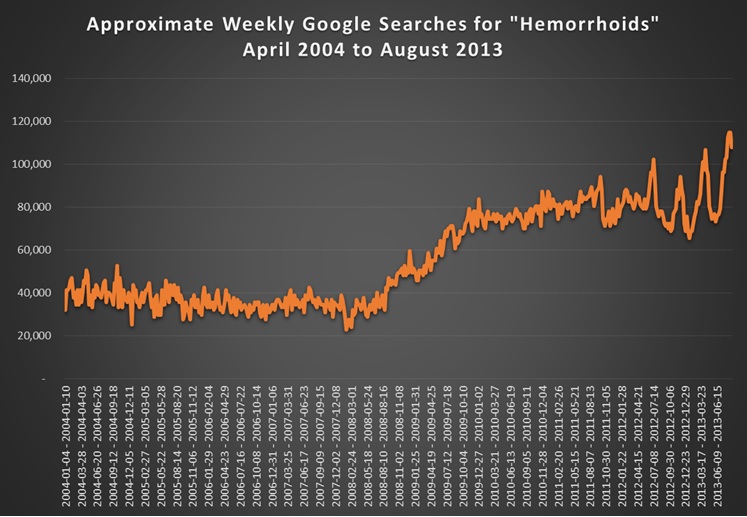Americans' Interest in Hemorrhoids Has Skyrocketed

The number of Americans searching online for information on hemorrhoids and how to treat them seems to have skyrocketed since 2008.
Data gathered from Google searches show that interest in the term "hemorrhoids" more than doubled between 2008 and 2013, according to a LiveScience analysis using Google Trends, a tool that shows how often a particular search term is entered in the search engine, relative to the total search volume in a specific country.
The term "hemorrhoids" was searched about 40,000 times weekly between 2004 and 2008, but this number started to rise during mid-2008, crept up to about 80,000 weekly searches in 2010, and reached nearly 120,000 during some weeks in 2013.
But what does the trend mean?
"My first guess would be that people are becoming more comfortable with the Internet, and they are going to look up more and more things, and hemorrhoids are a common condition," said Dr. Jesse Moore, an assistant professor of surgery at University of Vermont College of Medicine, and attending surgeon at Fletcher Allen Health Care in Burlington, VT.
In fact, one in three American adults have reported going online to try to figure out what medical condition they or someone else might have, according to a national survey conducted earlier this year by Pew Research Center.
It seems possible that conditions such as hemorrhoids might be among the most searched-for online because people may be embarrassed to talk about them with a doctor. But perhaps they shouldn't be: Technically, everybody has hemorrhoids. [7 Embarrassing Health Problems]
Sign up for the Live Science daily newsletter now
Get the world’s most fascinating discoveries delivered straight to your inbox.
What are hemorrhoids?
"One of the misconceptions about hemorrhoids is that 'nobody has it but me.' Actually, everybody has hemorrhoids, but not everybody has symptoms of hemorrhoids," Moore told LiveScience.
Hemorrhoids are normal parts of the human anatomy, and they serve a purpose. These little blood vessels act like water balloons inside the lower rectum, and help people control bowel movements.
But sometimes, hemorrhoids can become swollen or inflamed, causing symptoms such as bleeding or pain.
"I see a lot of people in my office with complaints of hemorrhoids. Only about half of the time is it actually that they have hemorrhoids that are symptomatic," Moore said. Because other conditions can cause the same symptoms, many people mistakenly think they have hemorrhoids.
The most common condition that people mistake for hemorrhoids are fissures, Moore said. Both can cause bleeding.
Fissures, which are tears in the skin of the lower rectum, are usually treated with topical medication applied to the surface of the fissure. However, some patients need surgery, he said.
Dr. Jeffrey S. Aronoff, a colorectal surgeon at Lenox Hill Hospital in New York, said he suspects people may be increasing searching for hemorrhoid information because advertisements about hemorrhoid treatment services are becoming more common.
"It's important that people be aware where they educate themselves about medical issues," because some health websites have inaccurate information, Aronoff said.
The best way to avoid getting symptomatic hemorrhoids or fissures is to avoid constipation and prolonged straining on the toilet. People should eat a high-fiber diet, consuming about 30 grams of fiber, as well as drinking about 2 liters of water a day, Moore said.
Fruits such as apples and pears (with skin) have about 4 to 5 grams of fiber. A bowl of a high-fiber cereal might have up to 8 grams, and a cup of cooked peas, lentils or beans has up to 15 grams of fiber. But there are certain foods that are constipating and should be avoided if people start having problems (bananas, for example).
When too much pressure is positioned on the blood vessels in the rectal area, hemorrhoids may bulge or become swollen. Pregnancy, heavy lifting, and long hours of sitting can increase blood flow into the hemorrhoids and result in their engorgement, increasing the risk of developing symptomatic hemorrhoids, Aronoff said. [9 Conditions That Pregnancy May Bring]
How can hemorrhoids be treated
Hemorrhoids come in two types; there's internal and there's external hemorrhoids, Moore said.
Internal hemorrhoids cause painless bleeding. One treatment option for internal hemorrhoids is to use what is called "rubberbanding," which is strangling the hemorrhoid by tying a rubber band at its base, cutting off the blood flow to the hemorrhoid. This is an outpatient procedure that a doctor performs in the office.
External hemorrhoids happen when hemorrhoids become irritated, and blood clots form under the skin. This is called a thrombosed, or clotted, hemorrhoid, and is painful and can bleed. The usual treatment for external hemorrhoids is to excise them.
"Over-the-counter stuff that people see advertised for hemorrhoids have never been shown in any good scientific study to help hemorrhoids," he said.
Generally, if people see blood in the stool, it's important to see a doctor, especially if they are over 40 years old. A doctor could help make sure the blood is from a hemorrhoid or a fissure, and not from a tumor in the colon, doctors said.
Also, when people experience discomfort in their rectal area, which could be caused by symptomatic hemorrhoids, fissures, warts or other conditions, it's a good idea to see a doctor who can help diagnose the problem.
"A lot of times it's not actually hemorrhoids, and would respond to different treatments," Moore said.
Email Bahar Gholipour. FollowLiveScience @livescience, Facebook & Google+. Original article on LiveScience.










